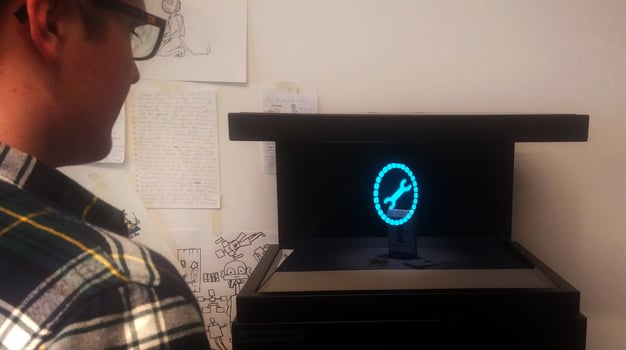At Salford University, the students of various digital areas have recently got the opportunity to see their work brought to life in a holographic display supplied by Realfiction. The Dreamoc HD3 display is part of the makerspace at the university’s Mediacity offering students a chance to see their digital solutions in a real setting and based in the basic idea of cooperating to make the most of emerging new media.
Salford University in Manchester is home to an array of studies in the vast digital realm, and the students working towards degrees in animation, computer and videogames, and digital media now have the chance to take their work to the next level at the Mediacity of the university as Realfiction has sponsored a holographic display for the students to try out their solutions in real life.

Collaboration is key
The Mediacity is a campus area of Salford University and home to big media corporations such as BBC and itv. This part of the university campus is meant to be an environment giving students a place to carry out their work and applying it to actual media as opposed to the closed setting of faculty rooms and computers. The goal is for students to experiment and try out things while getting hands-on learning and experience in working together.
The university encourages collaborations and has a good eye for the positive outcomes of students working collaboratively amongst themselves nurturing collaborations with the big media corporations neatly situated at the Mediacity as well as other companies interested in working on student projects.
Currently, Subaru is co-working with students on creating a complete point of sales environment, and there really is no end to the possibilities in regard to collaborations – it is entirely up to the imaginations of students and the brands that choose to work with them.

Creatively telling new stories
Alasdair Swenson is the Creative Technical Demonstrator of the makerspace, and he greatly appreciates the chance for the students to see their creations in an actual display. The idea is to experiment and learn by taking the classroom solutions into the next level and seeing how they work when coming to life in a holographic display.
Pointing out that students take to the new addition to their campus facilities, Alasdair Swenson says that they will quickly start thinking outside the box to fit things into it.
“Students of Computer and videogames will integrate Raspberry Pis and Arduinos and create a brand-new gaming platform, and our filmmaking students think of new ways to use the display to enhance a narrative,”
says Swenson, clearly impressed of the creativity of the students when incorporating the possibilities of a three-dimensional display into their studies and solutions.
Working with outside partners is a great opportunity for students to gain concrete experience and get a headway on possible career paths, and Alasdair Swenson is impressed with the students’ readiness to adopt the new technology into existing projects or even basing new projects on the possibilities of a holographic display.

